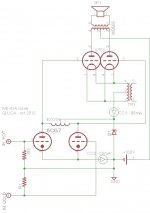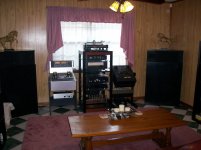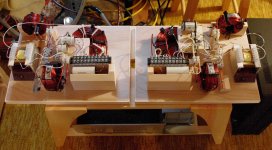Hi Erik,
I did not really start to work on it yet. I will rebuild a fully differential phono stage design which I had years ago first. I will probably apply some aspects from that design. Fully differential from in to out, choke in the cathode, common to both tubes. IT coupled.
But its too early really...
Best regards
Thomas
Thanks Thomas. I am indeed seeing more and more fully differential PP amps popping up, probably also due to availability of nice depletion mosfets. I am always reading your site, and when the PP comes I am sure you will post it over there as well.
Best regards, Erik
Hi!
Did you measure the actual power, you are pumping into your speakers? Hook up a scope to the output terminal of the amp, while connected to the speaker and watch the voltage peaks to get an idea which kind of power you are actually using
Thomas
Ok brother thanks for the info and tips, I am not hearing anything that tells me I need more power. My backup amp is a PP using 6L6 tubes at 25 wpc and it just seems to have so much authority that I thought if my 45 just had a little more power, well you get it...
Did you measure the actual power, you are pumping into your speakers? Hook up a scope to the output terminal of the amp, while connected to the speaker and watch the voltage peaks to get an idea which kind of power you are actually using
Thomas
Hi!
One is an active speaker set up in which the 45 drives the horn section, a 110dB field coil.
The other set up uses the 'Rho' from Haigner. It has a mere 91dB. This seems unusable with a 45, but since I rarely listen at loud levels, it works nicely. If I need more power I have plenty of amps to swap.
What is the minimum for you depends largely on your listening habits, your room and how honest the sensitivity measurement of the speaker manufacturer is.
Unfortunately many speaker manufacturers use the loudest spot in the frequency response of their speakers to measure the sensitivity.
I have seen speakers which had been claimed as being 98dB sensitive, which actually after measurement where more like 89dB!
Also the sensitivity is often given as dB per 2.8V in 1m rather than 1W. For 8 Ohm that translates to 1W, but if the speaker has 4 Ohms impedance that translates to 2W, which means the sensitivity is 3dB less for 1W!
Best is to try. Difficult to give any advice from the distance if speaker and amp are not known.
As a rough guideline I would say with honest 98dB and up most listeners will be happy with a 45 amp. With lower sensitivities, test it out
Best regards
Thomas
Can you please tell me what kind of speakers you drive with your 45 SE amps? What would be the minimum sensitivity you recommend?
One is an active speaker set up in which the 45 drives the horn section, a 110dB field coil.
The other set up uses the 'Rho' from Haigner. It has a mere 91dB. This seems unusable with a 45, but since I rarely listen at loud levels, it works nicely. If I need more power I have plenty of amps to swap.
What is the minimum for you depends largely on your listening habits, your room and how honest the sensitivity measurement of the speaker manufacturer is.
Unfortunately many speaker manufacturers use the loudest spot in the frequency response of their speakers to measure the sensitivity.
I have seen speakers which had been claimed as being 98dB sensitive, which actually after measurement where more like 89dB!
Also the sensitivity is often given as dB per 2.8V in 1m rather than 1W. For 8 Ohm that translates to 1W, but if the speaker has 4 Ohms impedance that translates to 2W, which means the sensitivity is 3dB less for 1W!
Best is to try. Difficult to give any advice from the distance if speaker and amp are not known.
As a rough guideline I would say with honest 98dB and up most listeners will be happy with a 45 amp. With lower sensitivities, test it out
Best regards
Thomas
Hi!
Did you measure the actual power, you are pumping into your speakers? Hook up a scope to the output terminal of the amp, while connected to the speaker and watch the voltage peaks to get an idea which kind of power you are actually using
Thomas
Hi Thomas,
I am getting right at 2 wpc to my speakers...
Hi!
Then more power would be helpful to also cover some headroom for transients.
Are you sure your speakers are 106dB? That would mean you are listening at very loud levels
Thomas
I am getting right at 2 wpc to my speakers...
Then more power would be helpful to also cover some headroom for transients.
Are you sure your speakers are 106dB? That would mean you are listening at very loud levels
Thomas
The last amp I built, actually just one channel running as I am missing a few minor parts, is a 6CG7 differential stage direct coupled to a VT52 differential stage. So far this is the best (maybe the second best after my EIMAC 75TL) amp I built. Filaments are AC heated and output noise is 0.8mVRMS. D1 is a string of 12V zeners for a total 252V but 6CG7 is feed from the 216V tap
Gianluca
Gianluca
Attachments
Hi Thomas,Hi!
Then more power would be helpful to also cover some headroom for transients.
Are you sure your speakers are 106dB? That would mean you are listening at very loud levels
Thomas
Yes I am sure I listen between 85-95db most of the time, just kinda depends on what it is and my mood. My speakers started life as Klipsch Corner Horns the only thing original are the 15" woofers and the cabinets. I have upgrade all other componets. The mid driver is a 2" BMS rated at 118db so I have them padded down to match the other drivers so 106db is about where they are...
If you want a cheap experiment, use 4P1L in triode instead of 45s. Similar power and plate impedance. I use these in PSE as my output stage, rather than PP, and I'm very happy. One good reason for this is that I can run the output 4P1Ls in filament bias, eliminating the cathode bypass or the requirement to make a fixed bias supply. Sound is very clean. It's possible that this in itself makes up for any intrinsic sound advantage of a 45 with a cathode bypass capacitor. I have a large box of 4P1L so I laugh at the prices of 45s.
45 Type Push/Pull
How many here use or have heard one of these type amps? What are the important factors here in this being able to produce quality sound of this tube with out the noise???
Can this amp achieve the sound quality of an SET amp?
Thomas really said it all, but really the real issue from my stand point is most people don't go far enough IMO in their vision or imagination of what it takes to get extraordinary sound. My philosophy is "if you want extraordinary sound you mush do extraordinary things."
If you want the SE sound character that stay SE IMHO
Best regards
Thomas
Hi Thomas,
Yes I am sure I listen between 85-95db most of the time, just kinda depends on what it is and my mood. My speakers started life as Klipsch Corner Horns the only thing original are the 15" woofers and the cabinets. I have upgrade all other componets. The mid driver is a 2" BMS rated at 118db so I have them padded down to match the other drivers so 106db is about where they are...
This is where you grabbed my attention. I own Klipsch as well (Fortes 98db/watt) of course highly modified. I have been DIYing for nearly the last 25yrs, I have 40yrs experience in the hobby. It was only when I began DIYing that I finally had some satisfaction.
When I said not far enough here is a typical George Wright 2A3 Monoblock contrasting a 45 Monoblock that I designed the circuit for my very good friend John. John did the layout with some assistance from me which is very unconventional but the amp is dead quite on his highly modified LaScala's.
An externally hosted image should be here but it was not working when we last tested it.
An externally hosted image should be here but it was not working when we last tested it.
An externally hosted image should be here but it was not working when we last tested it.
An externally hosted image should be here but it was not working when we last tested it.
Further I would like to thank Thomas for his work with tube full wave bridge rectifiers which was eventually added to the project using 4 6D22S's/mono along with an additional paralleled mains power transformer.
John has said that he has not heard the amp clip or sense any form of compression. I designed this thing to be ultra fast both in impact and recovery. He lives 450mi away from me but I did get a chance to hear it and he was right as all I heard was effortlessness. As to playing to 100db, I ran some SPL #'s on his system efficiency vs mine and our system max SPL levels match. His amps incorporate many of the same principles that I have in my amplifiers. And I can easily obtain 100db in my system from SET Mono's, 10 watts from a 811-10 running Class A2 with no sense of compression.
I hope you enjoy the photo's. I don't get here to often so please e-mail me if you'd like to know more on John's system and the design of John's BOS45 amplifiers.
SET12
1W and 86dB
Hi jcmusic, I am the guy SET12 was talking about with the 45SET. I run La scalas with stock drivers. I have a better midrange horn and a Universal crossover made of premium parts and that helps some but really we can't be that far apart...unless...
Is your room huge? How close do you sit? What is in the room that might absorb sound energy? Have you ever done work to your crossovers?
I get by with way less than a Watt but then again I have a separate sub woofer with it's own amp. There are lots of factors I guess, it is just funny that we like about the same SPL = 86-89dB for listening. One Watt should do you just fine IF you have everything else going right.
SET12 is a super smart guy. He is not conventional unless conventional makes sense. He has been ALL OVER the process of stereo's making music and I'd trust what he tell you.
What folks don't like and understand it completely is that what he is saying is not well corroborated by a crowd of engineers. His very well worked out numbers indicate that low DCR is an extremely good way to keep the music signal flowing freely, uncorrupted and whole all the way through the chain of events. When I heard his system I knew I had to try it. It was the most dynamic stereo I have ever heard and I have listened to quite a few systems that cost like houses cost.
Good sound comes through a commitment to physics not hyperbole. I don't know if you are going to believe me but my experience tells me you need to find what is choking off your 1 or 2 Watts because that is all you should need with even 104dB/Watt speakers. That's physics.
I have some ideas but SET12 could tell you better.
Don't give up on the 45 SET as a possible answer because mine rocks the house! If you don't have the heart to go "deep in" or "whole hog" to make the 45 work, try a 2A3 SET (a 2A3 is just a pair of 45s in one bottle )but don't go PP. Even the very best efforts of the very best designers can't seem to put the music back together again once you split it up. PP is a step in the wrong direction once you have committed the space, money and time to good efficient speakers. Don't break up the music if you can help it!
Hi jcmusic, I am the guy SET12 was talking about with the 45SET. I run La scalas with stock drivers. I have a better midrange horn and a Universal crossover made of premium parts and that helps some but really we can't be that far apart...unless...
Is your room huge? How close do you sit? What is in the room that might absorb sound energy? Have you ever done work to your crossovers?
I get by with way less than a Watt but then again I have a separate sub woofer with it's own amp. There are lots of factors I guess, it is just funny that we like about the same SPL = 86-89dB for listening. One Watt should do you just fine IF you have everything else going right.
SET12 is a super smart guy. He is not conventional unless conventional makes sense. He has been ALL OVER the process of stereo's making music and I'd trust what he tell you.
What folks don't like and understand it completely is that what he is saying is not well corroborated by a crowd of engineers. His very well worked out numbers indicate that low DCR is an extremely good way to keep the music signal flowing freely, uncorrupted and whole all the way through the chain of events. When I heard his system I knew I had to try it. It was the most dynamic stereo I have ever heard and I have listened to quite a few systems that cost like houses cost.
Good sound comes through a commitment to physics not hyperbole. I don't know if you are going to believe me but my experience tells me you need to find what is choking off your 1 or 2 Watts because that is all you should need with even 104dB/Watt speakers. That's physics.
I have some ideas but SET12 could tell you better.
Don't give up on the 45 SET as a possible answer because mine rocks the house! If you don't have the heart to go "deep in" or "whole hog" to make the 45 work, try a 2A3 SET (a 2A3 is just a pair of 45s in one bottle )but don't go PP. Even the very best efforts of the very best designers can't seem to put the music back together again once you split it up. PP is a step in the wrong direction once you have committed the space, money and time to good efficient speakers. Don't break up the music if you can help it!
Thanks for the reply and the pic's nice touch, the amps no doubt sound great but; they seem to be huge unless it's just the pic?Thomas really said it all, but really the real issue from my stand point is most people don't go far enough IMO in their vision or imagination of what it takes to get extraordinary sound. My philosophy is "if you want extraordinary sound you mush do extraordinary things."
This is where you grabbed my attention. I own Klipsch as well (Fortes 98db/watt) of course highly modified. I have been DIYing for nearly the last 25yrs, I have 40yrs experience in the hobby. It was only when I began DIYing that I finally had some satisfaction.
When I said not far enough here is a typical George Wright 2A3 Monoblock contrasting a 45 Monoblock that I designed the circuit for my very good friend John. John did the layout with some assistance from me which is very unconventional but the amp is dead quite on his highly modified LaScala's.
An externally hosted image should be here but it was not working when we last tested it.An externally hosted image should be here but it was not working when we last tested it.An externally hosted image should be here but it was not working when we last tested it.An externally hosted image should be here but it was not working when we last tested it.
Further I would like to thank Thomas for his work with tube full wave bridge rectifiers which was eventually added to the project using 4 6D22S's/mono along with an additional paralleled mains power transformer.
John has said that he has not heard the amp clip or sense any form of compression. I designed this thing to be ultra fast both in impact and recovery. He lives 450mi away from me but I did get a chance to hear it and he was right as all I heard was effortlessness. As to playing to 100db, I ran some SPL #'s on his system efficiency vs mine and our system max SPL levels match. His amps incorporate many of the same principles that I have in my amplifiers. And I can easily obtain 100db in my system from SET Mono's, 10 watts from a 811-10 running Class A2 with no sense of compression.
I hope you enjoy the photo's. I don't get here to often so please e-mail me if you'd like to know more on John's system and the design of John's BOS45 amplifiers.
SET12
Anyway thanks for the info and your time.
Hi John,Hi jcmusic, I am the guy SET12 was talking about with the 45SET. I run La scalas with stock drivers. I have a better midrange horn and a Universal crossover made of premium parts and that helps some but really we can't be that far apart...unless...
Is your room huge? How close do you sit? What is in the room that might absorb sound energy? Have you ever done work to your crossovers?
I get by with way less than a Watt but then again I have a separate sub woofer with it's own amp. There are lots of factors I guess, it is just funny that we like about the same SPL = 86-89dB for listening. One Watt should do you just fine IF you have everything else going right.
SET12 is a super smart guy. He is not conventional unless conventional makes sense. He has been ALL OVER the process of stereo's making music and I'd trust what he tell you.
What folks don't like and understand it completely is that what he is saying is not well corroborated by a crowd of engineers. His very well worked out numbers indicate that low DCR is an extremely good way to keep the music signal flowing freely, uncorrupted and whole all the way through the chain of events. When I heard his system I knew I had to try it. It was the most dynamic stereo I have ever heard and I have listened to quite a few systems that cost like houses cost.
Good sound comes through a commitment to physics not hyperbole. I don't know if you are going to believe me but my experience tells me you need to find what is choking off your 1 or 2 Watts because that is all you should need with even 104dB/Watt speakers. That's physics.
I have some ideas but SET12 could tell you better.
Don't give up on the 45 SET as a possible answer because mine rocks the house! If you don't have the heart to go "deep in" or "whole hog" to make the 45 work, try a 2A3 SET (a 2A3 is just a pair of 45s in one bottle )but don't go PP. Even the very best efforts of the very best designers can't seem to put the music back together again once you split it up. PP is a step in the wrong direction once you have committed the space, money and time to good efficient speakers. Don't break up the music if you can help it!
Thanks for replying, first off I am not giving up on the SET it is what I like... I thought about this some last night and I am gonna try a couple things first. Answer to your questions.
1 My room is small 13X14-15
2 I sit 11 feet from the speakers
3 I have two cabinets of LPs on either side of the room a single chair in the sweet spot.
My speakers are far from stock, I have ALK's Universal Xovers in them. They have a 2" BMS driver fro the mids, and upgraded tweeter and a 2" full tractrix wooden horn. The only thing still Klipsch is the cabinets and 15" woofers. Here is a pic it still looks like that for the most part, the coffee table is long gone.
Attachments
Thanks for the reply and the pic's nice touch, the amps no doubt sound great but; they seem to be huge unless it's just the pic?
Anyway thanks for the info and your time.
They are pretty big, pictured the John has them together they are about 3ft x 3ft. They a lot of iron but not utilized in classical design fashion. John's BOS45's use Silk grid chokes to help aid in clipping recovery. Each amplifier has over 900uf of capacitance that is highly isolated and aided what could be referred to as buffer chokes which feed his final caps. The design allows for great authority with transparency and speed. His EML45 is driven by a paralleled 12BH7 that is LED biased and has a plate choke, the 45 uses fixed bias with AC filaments for both tubes. The amplifiers DCR to the wall from each of its final caps is about 12 ohm's resulting in some serious impact. Most SET amplifiers typically have several hundred.
Pictured is Johns Tube Bridge Rectifier. His amplifier is modular so its very easy to further add enhancements like this.
Also the last photo with the iron which is missing I believe 6 pieces John appropriately named after the manufacture a "Hammond Army"
His DIY ALK Universal Network which is 12in by 16in and weighs 20lb each he is using North Creek Music Inductors I believe Johns are 10AWG which better then most (including the Solens) at coherancy in their working frequency range my own are 8AWG. He uses a higher quality Auto-transformer that uses Cardas wire. I use a German made C-Core pictured next to a stock Autotransformer. While the ALK is 50% larger then the stock the C-Core is 50% larger then the ALK.
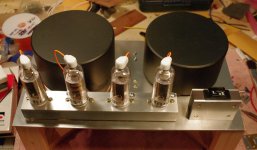
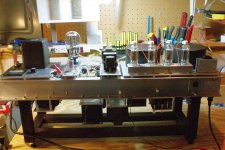
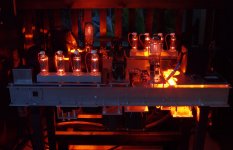
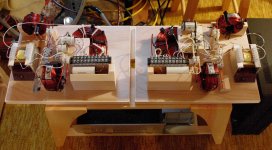
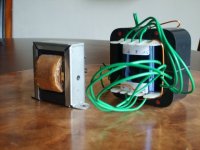
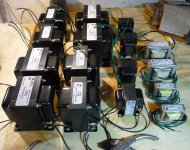
Last edited:
Not so very different you and me...
OK so you and I are not so very different in our rooms or listening. You have put serious thought and effort into improving your drivers and dispersion and too to the room effects!
I have attached a picture of my Universals, they are ALK designed but use Northcreek 8ga air cores and a autoformer done u by Intact Audio. The caps are just gen 1 Sonicaps with the recommended bypass caps...
I cannot begin to describe the difference the darn air cores made. I hated spending the money on them as an "experiment" but don't regret for a minute the cost now. It was just the logical extension of the low DCR "experiment" with the building of my amp!
Yup my amps are huge; most of it is power supply, orders of magnitude more power supply than "needed". It doesn't show much in the picture but the four chokes of the power supply underneath the amp and are about 9 pounds each. All four of them add up to 1H and have a DCR of 10 Ohms...total. It is the throughput of the power supply you want unabated. If you look at the amp as what it is, a valve, you are listening to the power supply.
I would rather you contact SET12 directly for the technical side of the explanation. Suffice it to say that in most designs work far too much inductance loss is designed in and it's been designed in so long that no one bats and eye at using 20H in a power supply. The resultant resistance is death to speed. There is only 1 resistor in my amp, its after the grid choke, just because...(there are bleeders of course but they are not at all in the signal path). Dan mentioned that I have gone to a bridge rectification using TV damper diodes (and dual power toroids) which also helped smooth out the rush of power...all 1.6 watts of it. To be fair I am sure there is LOTS of headroom in the "1.6W" To be sure when it is called for power makes it to the speakers!
All this to say: take a look at the design of your 45 and see how conventional it is. Think about jumping way out of the box. You could easily just try upgrading your air core inductors in your Universal crossover and listen. If lowering your DCR has a obvious effect there you have tasted the fruit!
OK so you and I are not so very different in our rooms or listening. You have put serious thought and effort into improving your drivers and dispersion and too to the room effects!
I have attached a picture of my Universals, they are ALK designed but use Northcreek 8ga air cores and a autoformer done u by Intact Audio. The caps are just gen 1 Sonicaps with the recommended bypass caps...
I cannot begin to describe the difference the darn air cores made. I hated spending the money on them as an "experiment" but don't regret for a minute the cost now. It was just the logical extension of the low DCR "experiment" with the building of my amp!
Yup my amps are huge; most of it is power supply, orders of magnitude more power supply than "needed". It doesn't show much in the picture but the four chokes of the power supply underneath the amp and are about 9 pounds each. All four of them add up to 1H and have a DCR of 10 Ohms...total. It is the throughput of the power supply you want unabated. If you look at the amp as what it is, a valve, you are listening to the power supply.
I would rather you contact SET12 directly for the technical side of the explanation. Suffice it to say that in most designs work far too much inductance loss is designed in and it's been designed in so long that no one bats and eye at using 20H in a power supply. The resultant resistance is death to speed. There is only 1 resistor in my amp, its after the grid choke, just because...(there are bleeders of course but they are not at all in the signal path). Dan mentioned that I have gone to a bridge rectification using TV damper diodes (and dual power toroids) which also helped smooth out the rush of power...all 1.6 watts of it. To be fair I am sure there is LOTS of headroom in the "1.6W" To be sure when it is called for power makes it to the speakers!
All this to say: take a look at the design of your 45 and see how conventional it is. Think about jumping way out of the box. You could easily just try upgrading your air core inductors in your Universal crossover and listen. If lowering your DCR has a obvious effect there you have tasted the fruit!
Attachments
"Think about jumping way out of the box."
I couldn't of said it better. It all depends on what one wants.
I simply could not afford $20,000 10 watt SET amplifiers and even then would they do what I wanted?
I wanted extraordinary and knew I had to do some extraordinary things to get extraordinary sound.
Is there more? yes, but I have jumped far enough out of the box to be way ahead of the game at least from my perspective.
And more satisfaction then I have had in years.
SET12
I couldn't of said it better. It all depends on what one wants.
I simply could not afford $20,000 10 watt SET amplifiers and even then would they do what I wanted?
I wanted extraordinary and knew I had to do some extraordinary things to get extraordinary sound.
Is there more? yes, but I have jumped far enough out of the box to be way ahead of the game at least from my perspective.
And more satisfaction then I have had in years.
SET12
Last edited:
Hi!
I disagree wholeheartedly. There are lots of ways to get good sound. It's all a matter of implementation. Some of the 'fastest' sounding amps I have built had lot's of inductance and high DCR in the power supply. It is rather easy to make a connection in your mind between speed and DCR of the power supply. In practice its not there.
Best regards
Thomas
Suffice it to say that in most designs work far too much inductance loss is designed in and it's been designed in so long that no one bats and eye at using 20H in a power supply. The resultant resistance is death to speed.
I disagree wholeheartedly. There are lots of ways to get good sound. It's all a matter of implementation. Some of the 'fastest' sounding amps I have built had lot's of inductance and high DCR in the power supply. It is rather easy to make a connection in your mind between speed and DCR of the power supply. In practice its not there.
Best regards
Thomas
design and implementation
You could be right; I know from experience outside of stereo that design implementation has a lot to do with success, perhaps more that the cleverness of the design. Who could argue that there is NOT more than one way to skin a cat?
I Can argue that this design works for speed/dynamics.
I have heard and I have read reports of many 45 based amps that just don't cut it. People love the harmonic structure but can't live with the drive/dynamics. Well this design delivers. It is a way to "have it all" IF you have some very efficient speakers.
My experience, my ears, tell me that this design (This very low DCR 45 amp) is far and away more "potent" than my old George Wright AU30, an all tube, class A, zero feedback, 30w PP mono block with interstage transformer arrangement which had won out over other designs to make me open my wallet at the $4500 mark.
I know the pain of a fellow who knows that SET is for him but needs the dynamics he used to know in more powerful amps to be happy. I found this solution. I offer up this solution. I have nothing to gain by someone else finding this solution, not in pride, not in money. It's SET12's design. SET12 offered it to me for free and helped me get it to a working state (man, this was my first build, I had a lot to learn!). It works! It is amazing in fact. It is free knowledge.
So yes, there are other SET designs that sound nice. I have head a few, not a hundred. I can tell you this one is the one that impressed me, more than anything I have heard at the last two AK fests, more than anything I have heard anywhere! It is designed around low DCR and this design works.
I would love to have a meet where the desire was to sort out one 45 based amp from another, not that I have anything to prove but I may have something to learn. I go by what my ears tell me. I drove 900 miles to hear SET12's amps and I'll drive 900 more to go to a 45 SET meet! Lets all learn about our favorite tube amp!
Cheers all!
You could be right; I know from experience outside of stereo that design implementation has a lot to do with success, perhaps more that the cleverness of the design. Who could argue that there is NOT more than one way to skin a cat?
I Can argue that this design works for speed/dynamics.
I have heard and I have read reports of many 45 based amps that just don't cut it. People love the harmonic structure but can't live with the drive/dynamics. Well this design delivers. It is a way to "have it all" IF you have some very efficient speakers.
My experience, my ears, tell me that this design (This very low DCR 45 amp) is far and away more "potent" than my old George Wright AU30, an all tube, class A, zero feedback, 30w PP mono block with interstage transformer arrangement which had won out over other designs to make me open my wallet at the $4500 mark.
I know the pain of a fellow who knows that SET is for him but needs the dynamics he used to know in more powerful amps to be happy. I found this solution. I offer up this solution. I have nothing to gain by someone else finding this solution, not in pride, not in money. It's SET12's design. SET12 offered it to me for free and helped me get it to a working state (man, this was my first build, I had a lot to learn!). It works! It is amazing in fact. It is free knowledge.
So yes, there are other SET designs that sound nice. I have head a few, not a hundred. I can tell you this one is the one that impressed me, more than anything I have heard at the last two AK fests, more than anything I have heard anywhere! It is designed around low DCR and this design works.
I would love to have a meet where the desire was to sort out one 45 based amp from another, not that I have anything to prove but I may have something to learn. I go by what my ears tell me. I drove 900 miles to hear SET12's amps and I'll drive 900 more to go to a 45 SET meet! Lets all learn about our favorite tube amp!
Cheers all!
Hi!
I believe that you like the sound of your SET amp. And I would probably like it too! Just wanted to point out, that high inductance and high DCR does not mean low fidelity as some people try to make others believe. These are opposite design philosophies.
You seem to have chosen a path which includes the PSU, which low inductance/low DCR designs usually do. That means everything in the PSU becomes very audible and needs to be carefully chosen. I am sure you managed that well, but others didn't. I have heard low DCR amps which sounded nasty to me, which doesn't mean of course that all low DCR designs sound this way. I have not heard all.
My philosophy is to exclude the PSU as far as possible. You can never fully exclude it of course, but reduce it's impact. I do that through high inductance chokes (which come with high DCR) and low capacitances values (which bring speed). I prefer the power supply parts including the transformer to be a bit lossy, even if that means they don't run as cool as others. This helps to keep all the mains nasties out of the amp. I have built amps with DCRs in the PSU which would make some people shudder, yet they sound powerful and fast.
Best regards
Thomas
I believe that you like the sound of your SET amp. And I would probably like it too! Just wanted to point out, that high inductance and high DCR does not mean low fidelity as some people try to make others believe. These are opposite design philosophies.
You seem to have chosen a path which includes the PSU, which low inductance/low DCR designs usually do. That means everything in the PSU becomes very audible and needs to be carefully chosen. I am sure you managed that well, but others didn't. I have heard low DCR amps which sounded nasty to me, which doesn't mean of course that all low DCR designs sound this way. I have not heard all.
My philosophy is to exclude the PSU as far as possible. You can never fully exclude it of course, but reduce it's impact. I do that through high inductance chokes (which come with high DCR) and low capacitances values (which bring speed). I prefer the power supply parts including the transformer to be a bit lossy, even if that means they don't run as cool as others. This helps to keep all the mains nasties out of the amp. I have built amps with DCRs in the PSU which would make some people shudder, yet they sound powerful and fast.
Best regards
Thomas
Guys you both make good points and I appreciate your passion, the only thing here we are trying to get done is to determine if I need a change of amps etc!!! Here is more info on my current system:
Jeff Korneff 45 SET Amp 2 WPC the amp is bone stock I use the EML 45 Solid Plate tubes with 6SN7 drivers and 5U4G rectifiers.
Klipsch K-Horns with original 15"woofers a 2" BMS Mid driver and a 2" wooden tractrix horn upgraded tweeters and ALK Universal Xovers...
Jeff Korneff 45 SET Amp 2 WPC the amp is bone stock I use the EML 45 Solid Plate tubes with 6SN7 drivers and 5U4G rectifiers.
Klipsch K-Horns with original 15"woofers a 2" BMS Mid driver and a 2" wooden tractrix horn upgraded tweeters and ALK Universal Xovers...
Hi!
Sorry for going off topic.
As mentioned above, if you are measuring close to 2W on your 45 while operating it at your usual listening levels, more power would be helpful.
In order to make a difference you would need something like 4 times the power.
Since your room is fairly small, you must be listening at ear shattering levels, if your speakers really are 106dB.
Best regards
Thomas
Sorry for going off topic.
As mentioned above, if you are measuring close to 2W on your 45 while operating it at your usual listening levels, more power would be helpful.
In order to make a difference you would need something like 4 times the power.
Since your room is fairly small, you must be listening at ear shattering levels, if your speakers really are 106dB.
Best regards
Thomas
- Home
- Amplifiers
- Tubes / Valves
- 45 Type Push/Pull Amps
